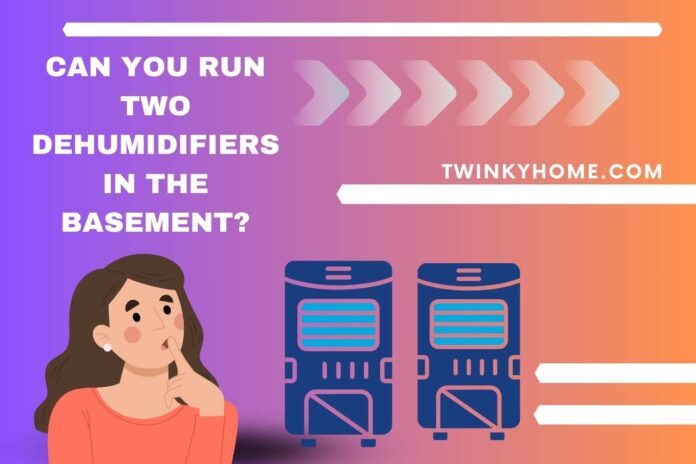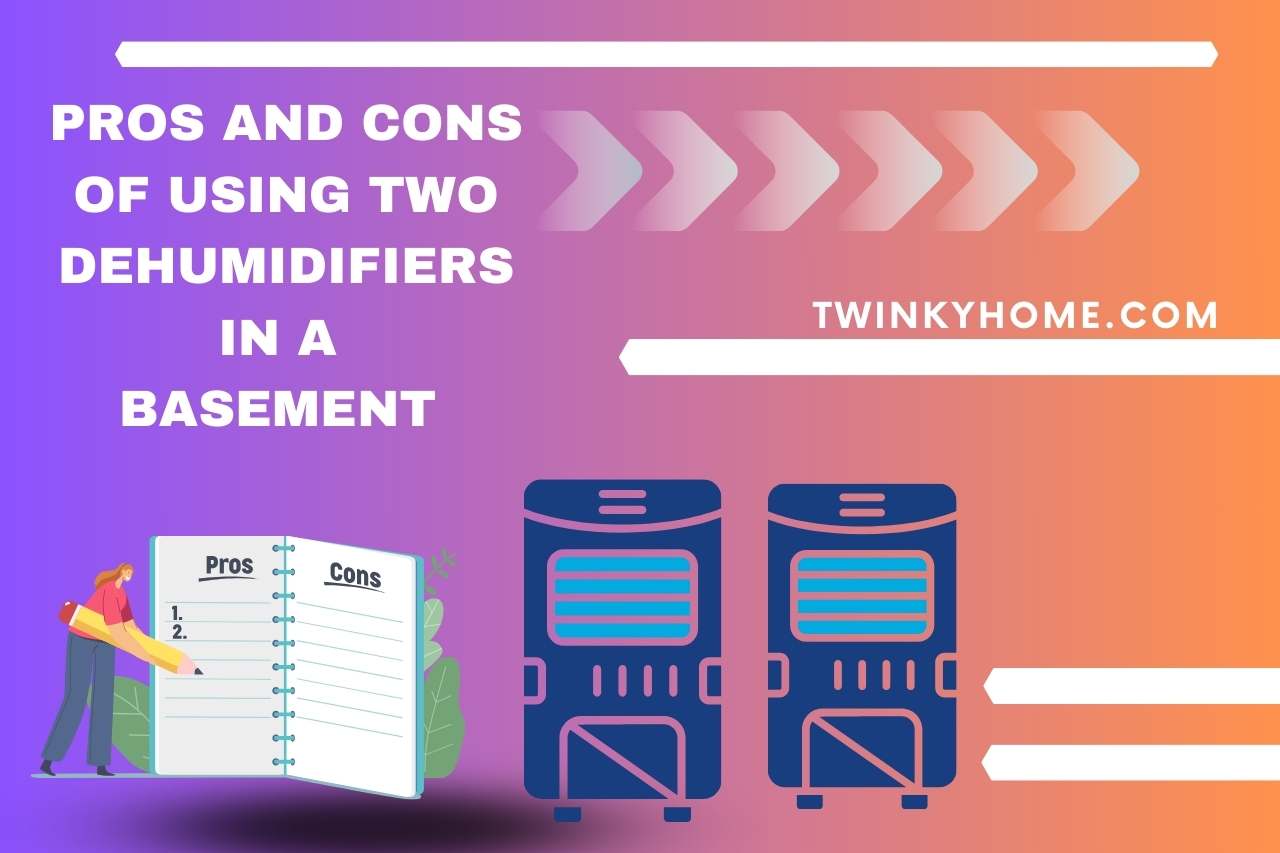‘Can you run two dehumidifiers in the basement?’ In case your single dehumidifier is unable to fully remove the moisture in your basement, you might have this question. In this guide, we’ll explore the advantages and considerations of utilizing dual units to tackle excess humidity. Whether you’re dealing with a large basement, persistent dampness, or seeking faster moisture removal, the use of two dehumidifiers can be a game-changer. From enhanced coverage to targeted problem-solving, we will also reveal the pros and cons of utilizing dual dehumidifiers, helping you make an informed decision on optimizing your basement’s environment. So, let’s explore the strategies that can transform your basement into a dry, comfortable space!
Can you Run Two Dehumidifiers in the Basement?
Yes, you can run two dehumidifiers in the basement. Indeed, running two dehumidifiers is generally fine and can be beneficial, especially if it’s a large or particularly damp space.
This can help cover a larger area and expedite the moisture removal process, preventing issues like mold and mildew.
However, it’s essential to consider the capacity of each dehumidifier and ensure they complement each other rather than overlap. Also, you have to monitor the humidity levels regularly to prevent over-drying, which may lead to other problems.
Proper ventilation and addressing the root cause of excess moisture, such as leaks or poor insulation, are equally crucial. Then, you can fix that particular issue rather than invest in another dehumidifier.
Ultimately, using multiple dehumidifiers can be an effective strategy, but it’s essential to strike the right balance for optimal results.
What Should you Consider Before Running Two Dehumidifiers in the Basement?
Before running two dehumidifiers in a basement, there are some key points to consider. Let us explain them one by one.
- Capacity and Coverage: Ensure that the combined capacity of both dehumidifiers is suitable for the size of your basement. They should cover the entire space effectively.
- Placement: Position the dehumidifiers strategically to maximize coverage and airflow. Avoid placing them too close to each other to prevent overlapping and inefficient operation.
- Humidity Level Monitoring: Regularly check and monitor the humidity levels in the basement. If you use hygrometers, it will help you maintain an optimal balance without overdrying the air.
- Drainage: Determine how each dehumidifier handles water removal. Some may have built-in pumps or continuous drainage options, reducing the need for frequent manual emptying of the water reservoirs. It would be better to opt for such a model for your ease.
- Energy Consumption: Consider the energy efficiency of the dehumidifiers. Running two units simultaneously will increase energy usage, so choose models with energy-saving features.
- Root Cause Addressing: While dehumidifiers help control moisture, address the root cause of the excess humidity, such as leaks or poor ventilation, to prevent recurring issues.
- Regular Maintenance: Remember that you have to keep both dehumidifiers clean and well-maintained to ensure optimal performance. Clean filters and coils as recommended by the manufacturer.
Why Do you Need to Use Two Dehumidifiers in the Basement?
Primarily, you will need to use two dehumidifiers if there is excessive moisture in your basement. Here, we have explained each cause in detail, so go through them attentively.
- Enhanced Coverage: Basements often have large and irregular layouts, and using two dehumidifiers ensures comprehensive coverage, addressing moisture in different areas simultaneously.
- Quicker Moisture Removal: Running two units accelerates the dehumidification process, especially in damp or excessively humid conditions, providing faster results.
- Optimal Humidity Control: Using multiple dehumidifiers helps maintain a more consistent and balanced humidity level throughout the entire basement, reducing the risk of mold and mildew growth.
- Large Basement Size: For sizable basements, a single dehumidifier may not be sufficient to manage the overall humidity effectively. Using two units would be the practical solution for such spacious environments.
- Customized Placement: With two units, you can strategically place them in different locations to target specific problem areas or high-moisture zones, maximizing efficiency.
- Redundancy and Backup: In case one dehumidifier malfunctions or requires maintenance, having a second unit ensures continuous moisture control. So, it is possible to prevent potential damage due to prolonged high humidity.
- Adaptation to Changing Conditions: Dual dehumidifiers offer flexibility to adapt to varying weather conditions or seasonal changes, maintaining optimal humidity levels year-round.
Pros and Cons of Using Two Dehumidifiers in a Basement
Here is a concise breakdown of the pros and cons you can expect when using two dehumidifiers in your basement.
Pros:
- Efficient Moisture Control: Using two dehumidifiers enhances the efficiency of moisture removal, preventing mold, mildew, and musty odors.
- Comprehensive Coverage: Undoubtedly, dual units provide better coverage in large or irregularly shaped basements, ensuring consistent humidity control throughout the space.
- Faster Drying: With two dehumidifiers, the drying process is expedited, which is particularly useful after water damage or during humid seasons.
- Targeted Problem Areas: You can strategically place each dehumidifier to target specific high-moisture zones, addressing localized issues effectively.
- Redundancy: If one unit malfunctions or requires maintenance, the other serves as a backup, so the moisture will be managed without a pause.
Cons:
- Increased Energy Consumption: Operating two dehumidifiers simultaneously can lead to higher energy consumption, potentially resulting in increased electricity costs.
- Initial Cost: Purchasing and installing two units may involve a higher upfront cost compared to a single dehumidifier.
- Space Requirements: Accommodating two units may be challenging, especially when your basement has limited space, potentially causing inconvenience.
- Maintenance Effort: Managing and maintaining two dehumidifiers requires more effort, including regular cleaning, filter replacement, and monitoring.
- Risk of Over-Drying: If not monitored closely, using dual dehumidifiers may lead to over-drying, causing discomfort and potential damage to wooden structures and musical instruments.
You May Also Like
- How to Drain a Basement Dehumidifier? Step-by-Step Guide
- How Long for Dehumidifier to Dry Basement? Unveiling the Drying Magic!
- How to Clean Basement Dehumidifier? Crystal Clear Air!
- How to Keep the Basement Dry Without a Dehumidifier? (Tips & Tricks)
- Does Dehumidifier in Basement Help Upstairs? The Ripple Effect!
- Whole House Dehumidifier vs Basement Dehumidifier – Choosing Wisely!
- How to Choose the Right Dehumidifier for the Basement? Basement Bliss!
- Why does My Basement Dehumidifier Ice Up? Decoding Dehumidifier Woes!
- How Long Should a Basement Dehumidifier Last? Investing in Comfort!








![OGX Biotin And Collagen Shampoo Review [Updated One] Ogx Biotin And Collagen Shampoo Review](https://twinkyhome.com/wp-content/uploads/2022/03/Are-chicken-Super-Noodles-vegetarian-1-100x70.jpg)